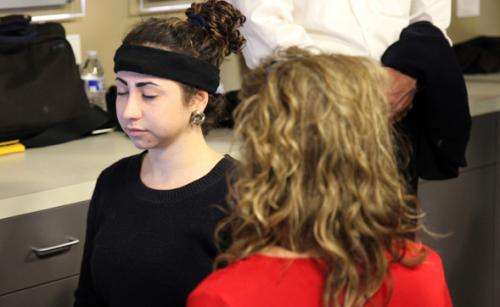The future of medicine in the palm of your hand

Let's say you're feeling a little … off. Disjointed and a bit dizzy. Seeing a doctor would be best, but in many parts of the country and the world, remoteness, the cost of healthcare, and limited availability of physicians can make seeking professional medical help impractical.
What if you could turn to the device in your nightstand and, within a few minutes, receive a quality diagnosis that will help you make potentially lifesaving medical decisions?
That's the goal of San Diego State University's X-Team as they compete for the Qualcomm Tricorder XPRIZE.
Along with 33 others from around the world, the team is racing to complete its version of a "Tricorder," a portable diagnostic wonder-device from the "Star Trek" series. On the line is a $10 million prize. The 3.5-year competition is sponsored by the XPRIZE Foundation, which offers cash incentives for high-risk, high-reward research.
Yesterday, the team unveiled a deconstructed prototype before a crowd of medical device manufacturers and other interested parties at SDSU's Donald P. Shiley BioScience Center.
On display were three components of the team's Tricorder—a headband brainwave recorder, a balance-board, and a blood sugar monitor—that will eventually be integrated into a single device, along with several other diagnostic components.
To win the competition, a team must build a device capable of accurately diagnosing 13 different "core" maladies such as anemia, urinary tract infection, type-2 diabetes and stroke, as well as 3 additional diseases from a list of electives. The device must also weigh 5 pounds or less and be both affordable and easy to use.
Playing to strengths
The SDSU X-Team's strategy, says team captain and SDSU graduate student Lambert Ninteman, is to take existing technologies and find a way to integrate them and make them communicate with one another, rather than building new technologies from scratch.
"We decided to take commercial technology off the shelf that is already FDA approved, tap into their capabilities and combine them using smartphone technology, and create the essence of a Tricorder," Ninteman said. "A Tricorder everybody could use, that everybody could get their hands on right now."
He added that the final product probably won't look very much like something out of "Star Trek," but instead will be something practical, something that manages to pull together several disparate components.
"Everyone wants the wonder-device with flashing lights and moving parts, but that's cost prohibitive," Ninteman said. "Tying a bunch of existing technologies with our software, we can do a whole lot more."
Team effort
The team gave brief demonstrations to the crowd of their prototype's components, albeit with all data-recording functions disabled and the promise that no diagnoses would be made that day. One sub-team working with a balance-board demonstrated how a user's balancing capabilities can be used to quickly diagnose concussions. Another demonstrated how its headband EEG recorder could interpret brainwaves to tell users about their stress and anxiety levels.
Currently, more than 30 students and faculty members from six of SDSU's seven colleges have representatives on the team. That let's-put-on-a-show mentality across the university is a major strength for SDSU, said Erik Viirre, a San Diego physician and technical and medical director for the Qualcomm Tricorder XPRIZE.
"I love the emphasis on bringing the whole institution together," he said. "It is not strictly a bio-sensing technology challenge. You have to have this kind of broad approach. It's an integration challenge."
Viirre's comments complement SDSU's recent focus on expanding its multidisciplinary work through the university's new Areas of Excellence, which spotlight the collaborative work being done across many of SDSU's colleges and departments.
The next step for the SDSU X-Team will be submitting documentation for the prize's qualifying round in May 2014. From there, up to 10 teams will advance to the final round in August.
Ninteman said that while he's pleased with the team's progress so far, much work remains to be done.
"It's like we're in lap 330 of the Indianapolis 500," he said.
Provided by San Diego State University




















